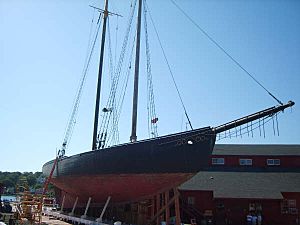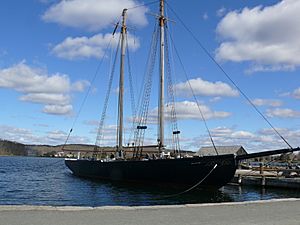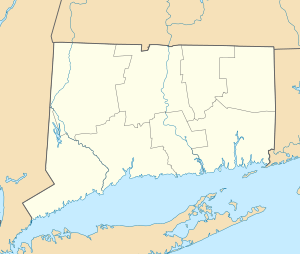L. A. Dunton (schooner) facts for kids

L. A. Dunton in dry dock
|
|
| History | |
|---|---|
| Owner | Mystic Seaport Museum |
| Builder | A.D. Story Shipyard |
| Launched | 1921 |
| Status | Museum ship |
| General characteristics | |
| Tonnage |
|
| Length | 104.3 ft (31.8 m) |
| Beam | 25 ft (7.6 m) |
| Draft | 11.6 ft (3.5 m) |
| Sail plan | Schooner |
|
L. A. Dunton (Schooner)
|
|
|
U.S. Historic district
Contributing property |
|

L.A. Dunton in Mystic Seaport
|
|
| Location | Mystic, Connecticut |
| Built | 1921 |
| Architect | Thomas F. McManus |
| Architectural style | Two-masted schooner |
| Part of | Mystic Bridge Historic District (ID79002671) |
| NRHP reference No. | 93001612 |
| Significant dates | |
| Added to NRHP | November 4, 1993 |
| Designated NHL | November 4, 1993 |
| Designated CP | August 31, 1979 |
The L. A. Dunton is a special fishing schooner that is now a museum ship. You can find her at the Mystic Seaport Museum in Mystic, Connecticut. She was built in 1921.
This ship is very important because she is one of only three ships of her kind still floating today. This type of schooner was once the most common fishing boat in New England. The L. A. Dunton fished in New England until the 1930s. Later, she sailed near Newfoundland into the 1950s. After being used to carry cargo for a short time, the museum bought her. They carefully brought her back to look just like she did when she was new.
The Story of the L. A. Dunton
The L. A. Dunton was designed to be like another ship called the Joffre. That ship was designed by Thomas F. McManus. He was a very important ship designer in the early 1900s. He created many fishing vessels.
The Dunton was built at the A.D. Story Shipyard in Essex, Massachusetts. She was launched, or put into the water, in 1921. She is one of only two ships from that shipyard that are still around. The Dunton was also one of the last big fishing boats that used only sails.
She was named after Louis A. Dunton. He was a sailmaker and one of the people who helped pay for the ship to be built. Even though many ships at the time were starting to use gasoline engines, the Dunton did not have one at first.
The Dunton worked as a fishing boat in New England for about ten years. In 1934, she was sold to Aaron Buffett. He lived in Grand Bank, Newfoundland. She then fished for cod near the Grand Banks until the 1950s.
Mr. Buffett changed the ship quite a bit. He took away her original sails and added a wheelhouse. This made her into a ketch, which is a type of boat with two smaller sails. In 1955, she stopped being a fishing boat. She was changed again to carry cargo along the coast. Many of her inside wooden parts were removed during this change.
The Mystic Seaport Museum bought the Dunton in 1963. They started to restore her right away. From 1963 to 1965, they put her original sails and back part (stern) back. Later, from 1974 to 1985, they worked even more to make her look exactly as she did when she was first built.
Because of her importance, the Dunton was named a National Historic Landmark in 1993. She was also added to the National Register of Historic Places that same year.
What Does the L. A. Dunton Look Like?
The Dunton is a schooner with two masts. Her body is made of wood. She has a rounded front (bow) and a long pole sticking out from the front called a bowsprit. Her two main masts are very tall, reaching about 112 feet and 8 inches (34.3 meters) high.
The main part of her body is about 104 feet and 3 inches (31.8 meters) long. But if you include the bowsprit, the whole ship is about 121 feet (37 meters) long. She is 25 feet (7.6 meters) wide. The part of the ship that sits under the water (her draft) is about 11 feet and 6 inches (3.5 meters) deep.
The Dunton weighs about 188 long tons when she is floating. She is officially registered as 134 gross tons and 94 net tons. Different kinds of wood were used to build her. These include white pine, yellow pine, white oak, and maple. The inside parts were made from sycamore and white pine.
Her original sails included a large mainsail and foresail. She also had smaller sails like gaff topsails, a fisherman staysail, a forestaysail, a jib, and a jib topsail. Even though she was built with space for an engine, one was not put in until 1923.
Below the main deck, there were sleeping areas for fifteen crew members in the front part of the ship (forecastle). The big middle section was for holding fish. The captain's room was at the back and could fit five crew members. It was common for captains on these fishing boats to eat and sleep with their crew.
Today, the Dunton is docked on the Mystic River. She is close to the Mystic Seaport visitors center. Another important ship, the steamer Sabino, is docked right next to her. The Dunton usually has all her sails up and is a popular exhibit for visitors to explore.


